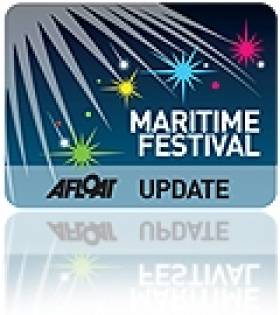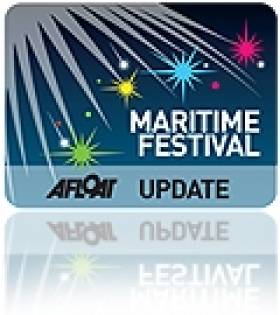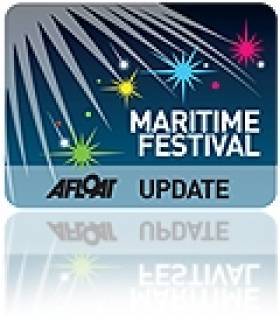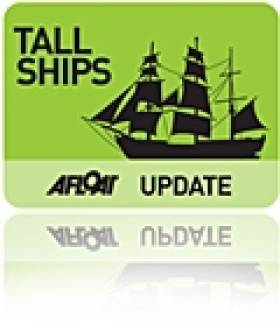Displaying items by tag: Maritime Festivals
Shanty & Seafaring Festival, Rosses Point
#SEA SHANTY FESTIVAL – Want to hear plenty of sea shanties and at the same time support the RNLI, then Rosses Point, Co. Sligo is the place to be during the three-day Sea Shanty & Maritime Festival held between the15-17th June.
This will be the third time that the coastal village is to host the festival, which to those who have attended previously will let you know is a great occasion, with lots of fun, a great atmosphere and a great standard of music, poetry, song and performances.
For this forthcoming festival there will be an increased number of overseas acts and added new dimensions to the festivals activities. The main festival concert will be held on 16th June at the Yeats Country Hotel featuring acts from Norway and several from the UK. Likewise this venue is to raise funds for the RNLI which is to hold a rescue display earlier that day starting at 3pm. This is to be followed by a Go As You Please Race at 4.00pm.
On the following Sunday, there will be a Wreath Laying and Blessing of the Boats ceremony at 12.30pm. There will be more activity on the water with a RNLI Open Day, rowing races and the staging of the Maugherow Cup, for times and festival programme visit www.rossespointshanty.com/programme.html
#MARITIME FESTIVALS - The Irish Whale and Dolphin Group (IWDG) will have a stand at the Maritime Matters Festival in Hook Head, Co Wexford this bank holiday weekend from 5-7 May.
Representing the IWDG are Deirdre Slevin and Paddy Roche, who will be on hand to present photos of recent whale activity off the Wexford coast, as well as giving the opportunity to look out for whales and dolphins from the watch tower.
Hook Head has already witnessed a wide range of cetacean activity in 2012, with the likes of fin whales, humpback whales, minke whales, common and Risso's dolphins, harbour porpoise and basking sharks visiting the waters of the 'Sunny Southeast'.
The annual Maritime Matters Festival will also feature displays from The Irish Coast Guard, Irish Water Safety and the Irish Seal Sanctuary, as well as displays and manoeuvres on the water by the Irish Marine Rescue Services.
Cick HERE for more details on the weekend programme of entertainment and outdoor food on the Hook Lighthouse website.
Sun, Sand and Sail at the Kilmore Quay Seafood Festival
The Kilmore Quay Seafood Festival starts this evening, now in its 42nd year, the four-day festival is surrounded by the culinary delights of locally caught fresh seafood, writes Jehan Ashmore.
In addition festival-goers can take part in the varied programme which caters for all age-groups. At 7.30pm tonight is the opening Grand Festival Parade featuring a 'Visitors From the Deep' float and Wexford's Community Samba Band 'Bloco de Fud Este'.
The festival will include a Seafood Platter Prize Competition, a children's creative art-workshop making 'Fish Kite-Windsocks', a Friday Fish Market with reduced prices and chefs cooking culinary dishes for sample-tastings and a Beach Band Barbecue.
On both the Saturday and Sunday there is the Tuskar Marine Modellors with their model boats and ships exhibition held in the Stella Maris Centre
and the Quay Times exhibition. Also throughout the weekend the Festival Arts Exhibition will be open in the RNLI Lifeboat House, noting Kilmore Quay is the first Irish lifeboat station to have the new Tamar-class lifeboat, the RNLB Killarney which can be viewed at its moorings.
On Saturday starting at 2.30pm is the "The Celtic Link Challenge" - Yacht Race when boats leave the marina at 3pm and return two hours later. The winners trophy will be presented in the Bird Rock Cafe at 6pm. If adverse weather conditions prevail the race will be re-scheduled for 2.30pm on the Sunday - weather permitting! For more information contact 086 2576862 and www.kilmorequayboatclub.com
To view the complete list of the festival programme, noting certain events and activities require an admission charge click HERE
- RNLI
- Tamarclass lifeboat
- Maritime Festivals
- Kilmore Quay Seafood Festival
- Kilmore Quay Marina
- Irish Seafood Festivals
- Stella Maris Centre
- RNLI Lifeboats
- RNLI Killarney
- Tuskar Marine Modellors
- Boat Models
- Seafood Platter
- Celtic Link ChallengeYacht Race
- Kilmore Quay Boat Club
- Fish Markets
- Beach Band Barbecue
- Celtic Link Ferries
‘Bounty’ Joins Belfast’s Titanic Maritime Festival
The US-flagged replica tallship H.M.S. Bounty arrived into Belfast Lough this morning for the Belfast Titanic Maritime Festival (24-26 June), writes Jehan Ashmore.
Measuring some 200 tonnes, the three masted-replica ship of the original H.M.A.V Bounty where the famous mutiny against Captain William Bligh took place in Tahiti in 1789, is to open to the public.
The replica was constructed in Nova Scotia of the original Hull-built vessel for the 1962 MGM film 'Mutiny on the Bounty' starring Hollywood screen legend Marlon Brando.
The Bounty was also used in the filming of Pirates of the Caribbean II and a Lone Wolf Production Group documentary on Blackbeard and has featured in several documentaries.
'Bounty' will be open to visitors (for information www.tallshipbounty.org) and is to be accompanied by the Jubilee Sailing Trust's Lord Nelson (www.jst.org.uk/).
The festival venue is at the Queen's Quay, Abercorn Basin and Arc, behind the Premier Inn Hotel at the Titanic Quarter.
As for the Titanic, tours of the old main offices of the H&W shipyard on the Queen's Road courtesy of the Titanic Quarter Ltd will be open to the public with displays relating to Titanic and Edwardian Fashion.
In addition Titanic Bus Tours lasting two hours which are free are available from the Belfast Welcome Centre, to contact Tel: 028 9024 6609.
For a complete listing of the festival events, dates and opening hours go to www.belfastcity.gov.uk/maritimefestival/index.asp
- Belfast
- Port of Belfast
- Lord Nelson
- Belfast Lough
- Titanic
- Jubilee Sailing Trust
- Titanic Quarter
- Belfast Harbour Commissioners
- Tahiti
- Harland & Wolff
- Belfast Lough News
- MGM
- Hollywood
- Maritime Festivals
- Mutiny on the Bounty
- Captain William Bligh
- Marlon Brando
- H.M.S. Bounty
- H.M.A.V. Bounty
- The Bounty
- MGM Film Studies
- Replica tallship
- Maritime Events
- SS Titanic
- H&W
- JST
- Holiday Inn
- Queen's Quay
- Abercorn Basin
- Titanic Quarter Ltd
- Belfast Welcome Centre
Navies Northern Adventure Head for 'Foyle Days'
On the naval front, LE Emer was built in Cork's Verolme Dockyard in 1978. She represents the oldest of the eight-strong fleet and is designed from the Naval Service's first purpose built patrol vessel OPV LE Deirdre (P20) but was modified to improve her stability and speed. This vessel was decommissioned several years ago and was converted into a private yacht.
The original BOFORS 40mm L60 gun of the LE Emer was recently upgraded to a BOFORS 40mm L70 to improve range and accuracy of her main armament. She alongside her 65m sisters LE Aoife (P22) and LE Aisling (P23) where all built primarily to patrol the Irish section of the European Economic Zone (EEZ).
During their careers the 'Emer' class vessels have also completed numerous re-supply missions to Irish troops serving overseas with the United Nations and in particular in the Lebanon. A crew compliment of 46 (5 officers) operate the vessels which are all now in their fourth decade of service.
OPV HMS Severn is the third of four 'River' class offshore patrol vessels and like her Irish counterpart is deployed on fishery duties. The 1,677 displacement tonnes vessel was built in 2001 in the UK'S south coast port of Southampton at Woolston Docks. Her home port for the 30 crew is at HM Naval Base in neighbouring Portsmouth.
She becomes the fifth ship to bear the name and with sisters HMS Mersey (P 282) and HMS Tyne (P 281) they are assigned to the Fishery Protection Squadron. Click the ship's diary to follow the ship news. The final member of the River class HMS Clyde (P 257) serves as a Falklands Islands Patrol Vessel (FIPV).
- yacht
- Clipper Round The World Race
- naval service
- Derry
- Royal Navy
- Londonderry
- Ports and Shipping News
- JOHANNA LUCRETIA
- Verolme Cork Dockyard
- United Nations
- Foyle Days
- Offshore Patrol Vessel
- Maritime Festivals
- LE Emer
- Emerclass
- LE Deirdre
- HMS Mersey
- Riverclass
- Schooner
- HM Naval Base Portsmouth
- Falklands Islands
Antigua On All-Island Visit
Antigua was originally a fishing boat built in 1957 at Thorne, Yorkshire but her appearance is completely different today. Gone are the fish as the vessel spent four years undergoing reconstruction for the purposes of accommodating paying-passengers. The work was completed in 1997 and this has included the provision of sixteen double cabins in luxurious surroundings.
Individual booking cruises can be made on the brigantine and her fleet-mates which are owned by the Tall Ships Company which take passengers on destinations not just in European waters but also to the Arctic.
The company also operate another brigantine the Artemis, the barque Artemis, the schooner Mare Frisium and the clipper Elizabeth. For further information about the company click here.


































































